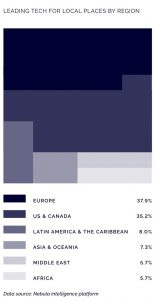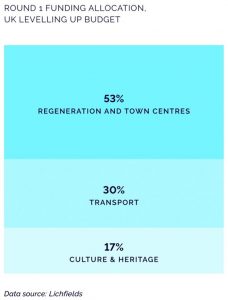With the government setting out its ambitions for levelling up the UK, Bluebell Drummond of StateUp examines the role of public purpose technology in building and improving infrastructure
In 2021, across the world, discussions of post-pandemic recovery centred around building back better. This narrative aligns with the current UK government’s agenda for levelling up. Published in February 2022, the Levelling Up White Paper highlighted technological progress as a key driver in addressing geographical disparities across the UK, reflected in both social and economic outcomes.
Technology that serves major public needs, such as building or upgrading public infrastructure, is defined as public purpose technology (PPT). Our latest publication, StateUp 21: Data-driven insights into global public purpose tech, aims to help public servants to understand what technologies are available to address pressing local and global public needs, and entrepreneurs and investors to navigate the gaps and opportunities. StateUp 21 combines macroanalysis based on tens of thousands of data points on PPT innovation with its centrepiece – detailed case studies of 21 emerging and leading start-ups addressing major public needs.
Last year, in our inaugural StateUp 21 publication, we predicted that 2021 would be an important year for developments in infrastructure and the built environment. This has been the case, particularly at the level of policy; for example, the far-reaching commitments in the $1.2tn US Infrastructure Investment & Jobs Act. In 2022, we expect there to be multiple implications for technology procurement and uptake at the local level as a result of policy developments, particularly for technology focused on resilience building. As the Levelling Up White Paper notes: cities, towns and communities must be physically and digitally connected if they are to thrive.
The paper also states that: technology adoption is a key driver of productivity. It goes on to highlight government investment in the adoption of 5G by start-ups, for example, through the £200m in funding for 5G testbeds and trials since 2017. This demonstrates a growing understanding of the key role start-up-driven PPT has to play in levelling up, both through technology innovation and adoption.
Transport and mobility
To reduce geographical inequalities, we must consider the broader local and regional environment beyond urban hubs. Positive agglomeration effects can emerge for towns that are well connected to local cities. In building these connections, it is important to identify technology needs; mobility start-ups serving rural populations often rely on an ecosystem of enabling technology such as geolocation technologies.
A core mission of levelling up is that, by 2030, “local public transport connectivity across the country will be significantly closer to the standards of London, with improved services, simpler fares and integrated ticketing”. PPT developers are innovating widely to improve mobility systems and encourage multimodal options: our PPT database, a core dimension of the Nebula PPT Intelligence Platform, contains over 90 of the highest quality start-ups working on improving public mobility. These range from efficient ticketing options, like those developed by StateUp 21 member Fairtiq (Switzerland), to sustainable micromobility options, like MIT-spin-off Superpedestrian (USA).
Beyond public transport, the Levelling Up Fund has allocations specifically for enhancing electric vehicle charging networks. Innovation in the development and adoption of electric vehicles is critical to decarbonising the transport sector. StateUp 21 member Electreon (Israel) has developed technology that charges electric vehicles wirelessly, helping charging infrastructure meet rising demands.

Digital connectivity
Digitally connecting people and places requires access to, and adoption of, communications technologies, such as 5G. The agility of start-ups means that they are often uniquely placed to apply new communications technologies to addressing public problems. Take MonoLets (USA), one of our “ones to watch” in 2022, whose digital labels use communications networks to provide real-time item level supply chain data.
The Levelling Up White Paper’s acknowledgement of the role of artificial intelligence (AI) as a driver of productivity in local contexts is reflected in our analysis of the PPT space: urban and local tech start-ups are most likely to say that they are using “AI/machine learning” as a key technology compared to start-ups focused on any other area. For example, StateUp 21 member UrbanFootprint (USA) uses machine learning to help urban planners and public officials make data-driven decisions, such as changing land usage policy or selecting sites for food distribution centres.

Net zero transition
Regeneration of local places necessarily involves cutting carbon emissions and establishing renewable energy supplies. Furthermore, the Levelling Up White Paper identifies that: the net zero transition will have a significant impact on the UK’s economic geography. StateUp 21 members working towards the net zero transition include Carbfix (Iceland), whose technology turns carbon emissions to stone, and CalWave (USA), which has developed wave energy converters that capture the vast power of the ocean.
However, we note that local places must also prepare to ride out the shocks of climate change. That is why innovations such as the new material that StateUp 21 member ECOncrete (Israel) is developing are so important: it is reportedly 10% stronger than traditional concrete, protecting from extreme weather conditions, while also having a 70% lower carbon footprint. Resilience building is key to this year’s edition of StateUp 21, which places special emphasis on regeneration and long-termism.
Empowering local decision makers
Central to the UK government’s long-term policy commitments to levelling up is the devolution of powers: “Levelling up will only be successful if local actors are empowered to develop solutions that work for their communities.” At StateUp, we know that PPT can be maximally applied when local decision makers are given appropriate powers.
The UK government intends for accountability frameworks and transparency mechanisms to underpin the new responsibilities for local places. PPT is increasing accountability and transparency by bringing together communities and local decision makers. For example, the StateUp 21 member the Future Fox (UK) has built a citizen engagement platform that empowers municipal governments and their residents to collaborate and make data-driven urban planning decisions.
In empowering local decision makers to utilise PPT, we highlight the important role of lesson and experience sharing. As local places continue to adopt PPT to address big public needs, cross-pollination will grow more important, enabling knowledge aggregation and the development of collective memory on what works or does not.
Bluebell Drummond
Researcher










![[VIDEO] HS2 completes 4,600-tonne viaduct slide across M6 The HS2 team completed a 17-hour long operation sliding the viaduct structure across the M6 without closing the motorway](https://www.pbctoday.co.uk/news/wp-content/uploads/2025/12/M6-South-viaduct-slide-taking-place-across-a-live-motorway-December-2025-218x150.jpg)



